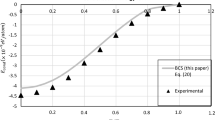Abstract
Fluctuation-induced corrections to the NMR relaxation rate T −11 in dirty two-dimensional superconductors above the superconducting transition (T>Tc) are re-investigated including dynamic fluctuations. Static fluctuations, as discussed by Kuboki and Fukuyama,1 dominate the fluctuation terms near Tc. We find that dynamic fluctuations become important for T/Tc≳1.05, and might even reverse the sign of the total fluctuation-induced contributions to T −11 . We observe that (T1T)−1 has a minimum at T=Tmin (·) for ·/Tc≳0.1 which depends on the pair-breaking parameter ·. Furthermore, we show that the fluctuation contributions to T −11 can be obtained numerically with very high accuracy from multipoint Padé approximants.
Similar content being viewed by others
References
K. Kuboki and H. Fukuyama,J. Phys. Soc. Jap. 58, 37 (1989).
K. Maki and H. Takayama,J. Low Temp. Phys. 5, 313 (1971).
P. A. Lee and M. G. Payne,Phys. Rev. Lett. 26, 1537 (1971);Phys. Rev. B5, 923 (1972)
J. Kurkijärvi, V. Ambegaokar, and G. Eilenberger,Phys. Rev. B 5, 868 (1972).
L. G. Aslamazov and A. I. Larkin,Phys. Lett. A 26, 238 (1968);Sov. Phys. Solid State 10, 875 (1968).
S. Ami and K. Maki,Phys. Rev. B 18, 471 (1978).
P. R. Graves-Morris and T. R. Hopkins,Numer. Math. 36, 111 (1981).
L. H. Kjaldman, J. Kurkijarvi, and D. Rainer,J. Low Temp. Phys. 33, 577, 1978.
A. A. Abrikosov, L. P. Gor'kov, and I. E. Dzyaloshinski,Methods of Quantum Field Theory in Statistical Physics (Prentice-Hall, Englewood Cliffs, N.J., 1963).
D. Rainer,Principles of ab initio calculations of superconducting transition temperatures, inProg. of Low Temp. Phys. X, Ch. 4 (North-Holland, 1986).
R. S. Thompson,Phys. Rev. B 1, 327 (1970),Physica 55, 296 (1971).
J. Keller and K. Korenman,Phys. Rev. Lett. 27, 1270 (1971);Phys. Rev. B 5, 4367 (1972).
G. M. Éliashberg,Sov. Phys. JETP 14, 886 (1962).
G. A. Baker and P. R. Graves-Morris, Encyclopedia of Mathematics and its Applications14,Padé Approximants (Part II: Extensions and Applications) (Addison-Wesley, 1981).
In order to check the accuracy of this method for another fluctuation problem, we have repeated the real-energy calculation of the dc-conductivity of Ami and Maki,6 and compared these results with calculation of σ(T) using the Padé-based method. Again the two results agreed within 1%. For details see: J. Heym, “Aslamazov-Larkin Diagram (contour integral versus Padé-based method)”, Internal Report (1990), Universität Bayreuth (unpublished).
J. Heym and D. Rainer,Helvetica Physica Acta 65, 415 (1991).
H. C. Thacher and J. Tukey, “Rational interpolation made easy by a recursive algorithm,” (1960, unpublished).
H. J. Vidberg and J. W. Serene,J. Low Temp. Phys. 29, 179 (1977).
Author information
Authors and Affiliations
Rights and permissions
About this article
Cite this article
Heym, J. Effects of superconducting fluctuations on the NMR relaxation rateT −11 of two-dimensional systems aboveT c . J Low Temp Phys 89, 869–884 (1992). https://doi.org/10.1007/BF00683891
Received:
Issue Date:
DOI: https://doi.org/10.1007/BF00683891




